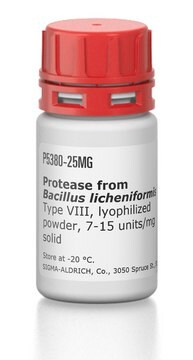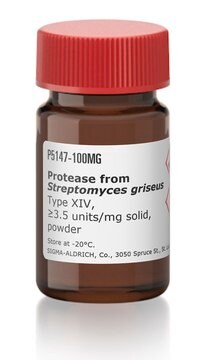P6236
Pyroglutamate Aminopeptidase from Pyrococcus furiosus
recombinant, expressed in E. coli, ~90% (SDS-PAGE), ≥5.0 units/mg protein
Synonyme(s) :
L-Pyrrolidone carboxyl peptidase
Se connecterpour consulter vos tarifs contractuels et ceux de votre entreprise/organisme
About This Item
Numéro CE :
Numéro MDL:
Code UNSPSC :
12352204
Nomenclature NACRES :
NA.54
Produits recommandés
Description générale
Pyroglutamate Aminopeptidase from Pyrococcus furiosus, also called the deblocking aminopeptidase, is a 42 kDa protein and belongs to aminopeptidase A family. It shares sequence homology with aminopeptidase in the active site, with conserved zinc and cobalt binding residues.
Application
Pyroglutamate Aminopeptidase, from Pyrococcus furiosus is a recombinant, thermostable aminopeptidase that is expressed in Escherichia coli. It is used to cleave pyroglutamic acid which allows analysis of N-terminal sequences of peptides.
The enzyme from Sigma has been used for the removal of pyroglutamate (pGlu) N-terminal blocking group, under reduced conditions, prior to N-terminal sequencing of purified cassiicolin.
Thermostable aminopeptidase that liberates N-terminal pyroglutamic acid from proteins and peptides prior to Edman degradation.
Actions biochimiques/physiologiques
Pyroglutamate Aminopeptidase (PGP 1) interacts with immunoglobulin, functions as inflammatory cytokine and modulates immune response. The levels PGP 1 is elevated during inflammation.
This enzyme is specific for N-terminal pyroglutamic acids. It cleaves the N-terminal pyroglutamic acid from proteins and peptides prior to Edman degradation. The optimal temperature range is 95 to 100 °C and the optimal pH range is 6.0 to 9.0.
Définition de l'unité
One unit will hydrolyze 1 μmol of pyroglutamate p-nitroanilide per minute at pH 7.0 at 37 °C.
Forme physique
Lyophilized powder containing sodium phosphate
Notes préparatoires
Reconstitute the vial of enzyme with 50 μl of 50 mM sodium phosphate, pH 7.0, with 10 mM DTT and 1 mM EDTA. The reconstituted solution should be stored at -20 °C.
Mention d'avertissement
Danger
Mentions de danger
Conseils de prudence
Classification des risques
Eye Irrit. 2 - Resp. Sens. 1 - Skin Irrit. 2 - STOT SE 3
Organes cibles
Respiratory system
Code de la classe de stockage
11 - Combustible Solids
Classe de danger pour l'eau (WGK)
WGK 3
Point d'éclair (°F)
Not applicable
Point d'éclair (°C)
Not applicable
Équipement de protection individuelle
Eyeshields, Gloves, type N95 (US)
Certificats d'analyse (COA)
Recherchez un Certificats d'analyse (COA) en saisissant le numéro de lot du produit. Les numéros de lot figurent sur l'étiquette du produit après les mots "Lot" ou "Batch".
Déjà en possession de ce produit ?
Retrouvez la documentation relative aux produits que vous avez récemment achetés dans la Bibliothèque de documents.
Frédéric de Lamotte et al.
Journal of chromatography. B, Analytical technologies in the biomedical and life sciences, 849(1-2), 357-362 (2006-11-23)
Cassiicolin, a phytotoxin produced by the necrotrophic fungus Corynespora cassiicola, was purified to homogeneity from a rubber tree isolate. The optimized protocol involves reverse phase chromatography followed by size exclusion chromatography, with monitoring of the toxicity on detached rubber tree
Pyroglutamate aminopeptidase 1 may be an indicator of cellular inflammatory response as revealed using a sensitive long-wavelength fluorescent probe
Gong Q, et al.
Chemical Science, 7(7), 4694-4697 (2016)
A Ultrasensitive Near-Infrared Fluorescent Probe Reveals Pyroglutamate Aminopeptidase 1 Can Be a New Inflammatory Cytokine
Gong Q, et al.
Advanced science (Weinheim, Baden-Wurttemberg, Germany), 5(4), 1700664-1700664 (2018)
New deblocking aminopeptidases from Pyrococcus horikoshii
Mori K and Ishikawa K
Bioscience, Biotechnology, and Biochemistry, 69(10), 1854-1860 (2005)
Marie Schaeffer et al.
Molecular and biochemical parasitology, 150(2), 318-329 (2006-10-10)
Pyroglutamyl peptidases I (PPI) are cysteine peptidases of the clan CF, family C15, which hydrolyse N-terminal l-pyroglutamyl residues (l-pGlu). The l-pGlu modification is a post-transcriptional modification that confers relative aminopeptidase resistance and, in some cases, is essential to the modified
Notre équipe de scientifiques dispose d'une expérience dans tous les secteurs de la recherche, notamment en sciences de la vie, science des matériaux, synthèse chimique, chromatographie, analyse et dans de nombreux autres domaines..
Contacter notre Service technique





